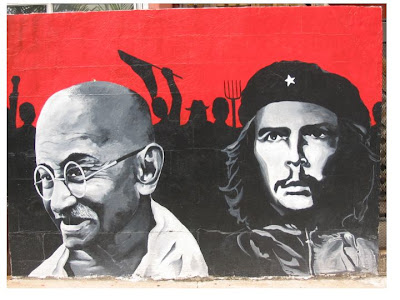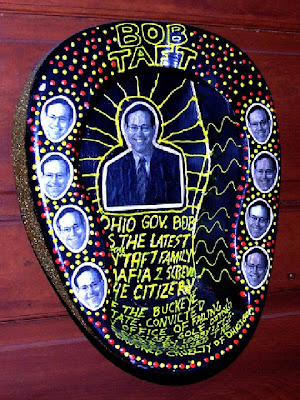Stadt luft macht frei, City air makes one free.
This old German saying, perhaps coming from the Middle Ages or Renaissance, could be the theme of a cultural tendancy of modern America, too, as it is so contrary to the American ethos, which is, at heart, anti-urban. As we here in the Dayton region know all too well.
That cultural tendancy is for cultural and political free thinkers and innovators to seek out the city as a favorable mileau for innovation, leading to the formation of urban bohemia, but also the ongoing connection of this bohemia to a left politlcal turn, meaning either revolution or reform, either socialist or anarchist.
This phenomenon was perhaps already visible at the dawn of Bohemia, in 19th century Paris.
Bohemia & The Paris Commune
Bohemia was first named by Henry Murger, staging a play on Bohemia in 1849 and later publishing Scenes de la Vie de Boheme in 1851, just after the 1848 revolution, the one that overthrew Louis Phillipe. It's unclear what role Murgers bohemians played in that revolution. In fact it appears that Bohemia was pretty much apolitical at first. Yet it's certain members of the bohemian subculture participated in the great proleterian insurrection of 1871, the Paris Commune. 
Perhaps that is a bohemian in the red coat, on the right of the above illustration of the Communards marching with Marianne, symbol of the French Revolution. Both literary figures of Parisian bohemia and at least one artist, Gustave Courbet, participated in the Paris Commune.
And this wasn't "left wing political" style, as over 20,000 died or were executed, with even more deported the colony of New Caledonia. Observers hostile to the Commune noted that it was "the death of Bohemia".
Another time and place where urban bohemia (and when isn't it urban?) intersected with politics, or at least social criticsm, was in Berlin, perhaps during the Wilhelmine era but certainly after 1918 with the coming of the Weimar Republic. This was most clearly seen with Berlin manifestation of the Dada movement. Dada was essentially apolitical in its original form in Zurich, but took a decidely left wing turn in Berlin, with artists such as the painter/illustrator Georg Grosz and collagist John Heartfield creating bitter, politcally charged artworks. It must be said that Grosz himself was no follower of any political line, distrusting ideology and political supermen, as he makes clear in his excellent autobiography: Ein klienes Ja und ein grosses Nein (A small Yes and a big No)
The Political Turn in American Bohemia
The first urban bohemia in the United States was probably Greenwich Village, which became a location for artists and writers in the early 20th century (perhaps earlier?). The development of the Village as an artists enclave parallelled the great "second immigration" to America from eastern and southern Europe and the second wave industrialization.
Artists of this era documented and even celebrated this booming urban world, especially artists of the "Ash Can School". One of these was John Sloan, one of the great painters of the American city, as demonstrated by this wonderful painting of a part of New York. Greenwich Village was also a center of political and social creativity. An example of this was The Masses, a magazine put out by the Village creative class. In the example below the same John Sloan who did the above painting provided this cover on the miners strike in Ludlow, Colorado (later immortalized in the Woody Guthrie song "The Ludlow Massacre").
Greenwich Village was also a center of political and social creativity. An example of this was The Masses, a magazine put out by the Village creative class. In the example below the same John Sloan who did the above painting provided this cover on the miners strike in Ludlow, Colorado (later immortalized in the Woody Guthrie song "The Ludlow Massacre"). The Village tradition of politically committed artists, writers, and illustrators lived on into our times. A good example is World War 3 Illustrated, a collection of comix and illustrations put out by people associated with the East Village scene, such as Eric Drooker and Peter Kuper, The East Village was a modern geographical and cultural expansion of the old Greenwich Village of The Masses and Ashcan School.
The Village tradition of politically committed artists, writers, and illustrators lived on into our times. A good example is World War 3 Illustrated, a collection of comix and illustrations put out by people associated with the East Village scene, such as Eric Drooker and Peter Kuper, The East Village was a modern geographical and cultural expansion of the old Greenwich Village of The Masses and Ashcan School. This same East Village scene was the setting for the popular musical Rent.
This same East Village scene was the setting for the popular musical Rent.
One doesn't usually associate musicals with either bohemia or political content, but Rent is perhaps the exception. The story of Rents relation to 19th century Paris via Puccini is probably known to readers thus need not be detailed here. What is probably not known is that the writer/composer Jonathan Larson was himself quite political, having developed an earlier musical on the right wing ascendence in 1980s America. And Larson pretty much lived the bohemian life of little money and day jobs, concentrating on his art.
And of course there is that theme of AIDS running through the musical. In fact one thing that made Rent radical was it's putting of gay and lesbian relationships on equal footing as straight ones.
Urban bohemia had long provided cover for sexual innovators and non-standard relationships, so became a tolerant mileau for gays and lebsians. One of the sources of modern gay rights movmenet came out of the Greenwich Village bohemia, the explicitly political Gay Liberation Movement.
Art and politics were to cross again with the advent of AIDS and the hostile social and political climate the disease engendered. One response was via the work of artists like Keith Haring, part of the street art scene, and the edgier David Wojnarowicz, who went beyond art and fought legal battles in the culture war against the right wing. Haring was already well known in art circles for his graffitti-inspired work when he joined the new ACT-UP movement. ACT UP is a good example of the politicl potential of a radicalized creative class. In this case it was not just artists but individuals involved in commercial art, the adverstising industry, who developed a potent visual identity for the movement, which was innovative in agit-prop tactics, civil disobedience, and media manipulation.
Haring was already well known in art circles for his graffitti-inspired work when he joined the new ACT-UP movement. ACT UP is a good example of the politicl potential of a radicalized creative class. In this case it was not just artists but individuals involved in commercial art, the adverstising industry, who developed a potent visual identity for the movement, which was innovative in agit-prop tactics, civil disobedience, and media manipulation. This continued on into non-gay alternative politics, probably best known via the anti-globalization demonstrations in Seattle, but also via the Indymedia/Infoshop movement, which is probably more anarchist than left (if one had to put a label on all this).
This continued on into non-gay alternative politics, probably best known via the anti-globalization demonstrations in Seattle, but also via the Indymedia/Infoshop movement, which is probably more anarchist than left (if one had to put a label on all this). New York has been mentioned a lot. But urban bohemias exist outside of NYC. Particularly on the West Coast, but also here in the Midwest, in Chicago.
New York has been mentioned a lot. But urban bohemias exist outside of NYC. Particularly on the West Coast, but also here in the Midwest, in Chicago.
Chicago had it's own Greenwich Village in Tower Town, the neighborhood directly west of the old Water Tower, around Bughouse Square (traditionally the Speakers Corner of Chicago), an intersection of the political, literary, and artistic (as can be seen by this collection on Chicago's free speech tradition. Frequently seen in that collection is the Dill Pickle Club, which rang the same politico-cultural changes as Greenwich Village.
Chicagos politicized bohemian spirit continues one in modern things, like some of the plays of Theatre Oobleck. And some of the newer neighborhoods, which are described as "hipster" but also have a certain political turn, as one can see by these pix of a mural on various freedom fighters, in the traditional colors of anarchy and revolution, red and black.
The Mexican revolutionary Zapata Bob Marley and some woman who I don't recognize.
Bob Marley and some woman who I don't recognize.
An odd juxtaposition, Ghandi and Che Guevera. Could they be any more different in style?
Dayton Bohemia and Left Wing Political Style
Yer humble host wouldn't know because, though a longtime lefty in spirit, he's not part of the local bohemia. Since the scene here is more music based one won't see (or hear) much politics because, unlike in Europe, the US alt/indy scene isn't that political. Yes, the left does have the best music, but its usually the British left.
Locally, if there is a political turn it's more of a libertarian one, or indifference to politics (which is the usual image of the bohemian, someone who lives for art)
About the only local artist that works political content into his work is Drexel Dave Sparks, though he's probably more a libertarian than a lefty (based on his previous incarnations online as Sparkdog, host of the late, lamented Fat City News). An example of DD's political content; bedpan commentary on Bob Taft:
I recall one other local visual artist (whos name escapes me, but I do know he is an Iraq veteran) who's done some interesting things on the Iraq War and related themes. And there is a fellow associated with The Circus who does rap/spoken word with some proto-political content..more about social conditions...which have political implications.
And that's about it for Dayton. Which brings up the the fact that this political turn in urban bohemia is probably found only certain large cities. Yet it neglected aspect of the creative class concept, which tends to depoliticize the cultural creative scene, rather than recognize a bohemian tendancy to political radicalism, or, at very least, political critique.
Sunday, July 19, 2009
Urban Bohemia and Left Wing Political Style
Subscribe to:
Post Comments (Atom)

3 comments:
Cool post. The 60's 70's Dayton Hippie scene is interesting. Do you think the Garden Station, fixed-gear bike, young hipster crowd is the contemporary extension of the Urban Bohemia? I don't know their politics exactly, but they seem somewhat active in town. Or do we have the mass/density for a recognizable Bohemian area?
Drexel Dave's work is awesome. I hope he plays another show soon.
In Dayton(well more Kettering) I'm an Anarcho-Communist and have influenced many of my friends so that they now lean towards, or are sympathetic to the cause of revolution. And I'm in a political band, Attack Now! where I write political lyrics over music that's a lot like Rage Against the Machine.
The woman you don't recognize in the mural with Bob Marley is Aung San Suu Kyi, democratically elected Prime Minister of Burma and political prisoner - her and Bob go together, p'raps, a little better than Gandhi and Che.
Post a Comment